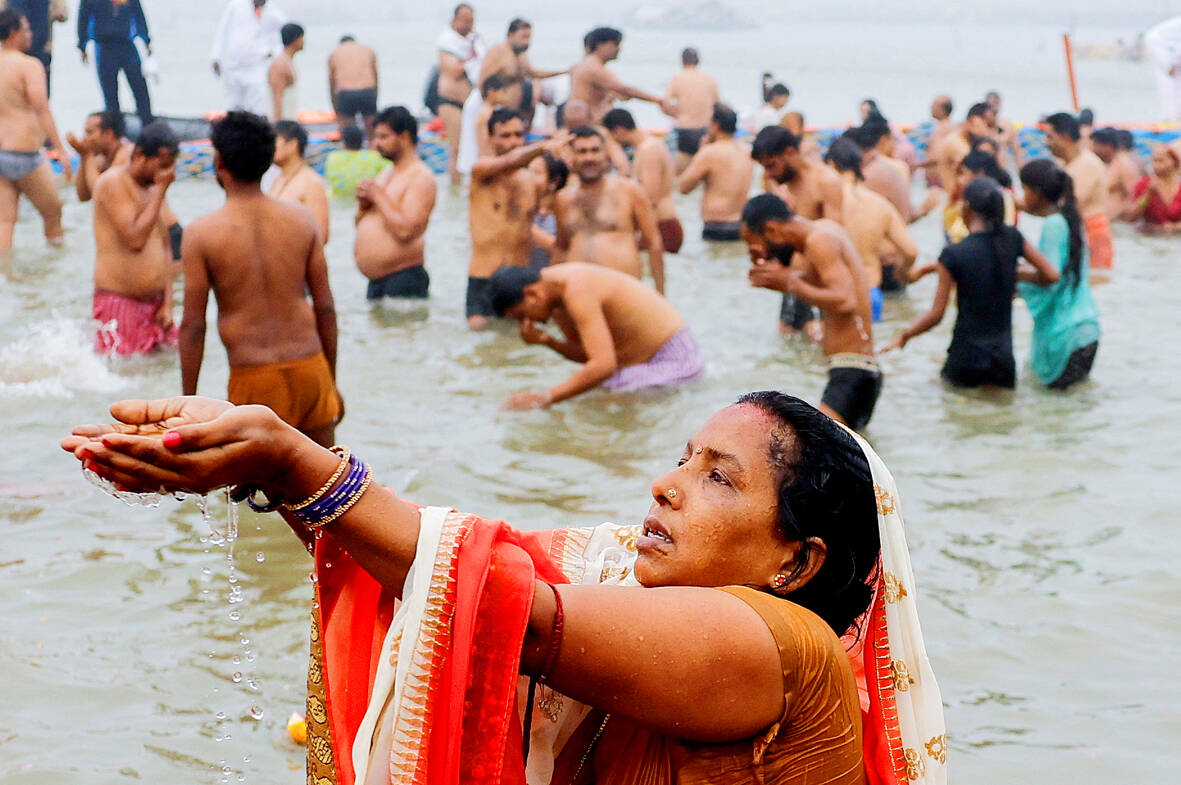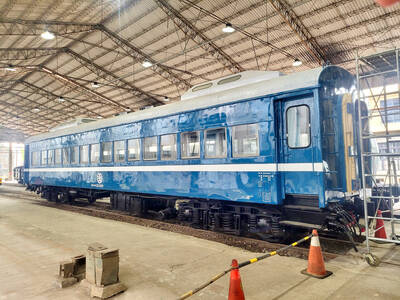Vast crowds of Hindu pilgrims in India began bathing in sacred waters yesterday as the Kumbh Mela festival opened, with organizers expecting 400 million people — the largest gathering of humanity.
The millennia-old Kumbh Mela, a show of religious piety and ritual bathing — and a logistical challenge of staggering proportions — is held at the site where the Ganges, Yamuna and mythical Saraswati rivers meet.
In the cool pre-dawn gloom, pilgrims surged forward to begin bathing in the waters.

Photo: Reuters
“I feel great joy,” said Surmila Devi, 45. “For me, it’s like bathing in nectar.”
Businesswoman Reena Rai’s voice quivered with excitement as she spoke about the “religious reasons” that brought her to join the sprawling tents, packed along the river banks in the north Indian city of Prayagraj in Uttar Pradesh state.
“As a Hindu, this is an unmissable occasion,” said the 38-year-old, who traveled around 1,000km from Madhya Pradesh state to take part in the festival, which runs until Feb. 26.
Saffron-robed monks and naked ash-smeared ascetics roamed the crowds offering blessings to devotees, many of whom had walked for weeks to reach the site.
The massive congregation is also an occasion for India’s Hindu nationalist government to burnish its credentials.
Prime Minister Narendra Modi called it a “divine occasion,” that brings together “countless people in a sacred confluence of faith, devotion and culture.”
Yogi Adityanath, a Hindu monk and Utter Pradesh’s chief minister, welcomed devotees to “experience unity in diversity” at the “world’s largest spiritual and cultural gathering.”
‘SCALE OF PREPARATIONS’
Organizers say the scale of the Kumbh Mela is that of a temporary country — with numbers expected to total around the combined populations of the US, so you can imagine the scale of preparations,” festival spokesman Vivek Chaturvedi said.
Hindu monks carried huge flags of their respective sects, while tractors turned into chariots for life-size idols of Hindu gods rolled by behind them accompanied by elephants.
Pilgrims exulted in the beat of drums and honking horns. The festival is rooted in Hindu mythology, a battle between deities and demons for control of a pitcher containing the nectar of immortality.
Organizing authorities are calling it the great or “Maha” Kumbh Mela.
‘ONE WITH GOD’
The riverside in Prayagraj has turned into a vast sea of tents — some luxury, others simple tarpaulins.
Jaishree Ben Shahtilal took three days to reach the holy site, journeying with her neighbors from Gujarat state in a convoy of 11 buses over three days.
“I have great faith in god,” she said. “I have waited for so long to bathe in the holy river.”
Around 150,000 toilets have been built and a network of community kitchens can each feed up to 50,000 people at the same time.
Another 68,000 LED light poles have been erected for a gathering so large that its bright lights can be seen from space.
The last celebration at the site, the ardh or half Kumbh Mela in 2019, attracted 240 million pilgrims, according to the government.
That compares to an estimated 1.8 million Muslims who take part in the annual hajj pilgrimage to Mecca in Saudi Arabia.
Indian police said they were “conducting relentless day-and-night patrols to ensure top-notch security” for the event.
Authorities and the police have also set up a network of “lost and found” centers and an accompanying phone app to help pilgrims lost in the immense crowd “to reunite with their families.”
India is the world’s most populous nation, with 1.4 billion people, and so is used to large crowds.
Temperatures hovered around 15 degrees Celsius overnight, but pilgrims said their faith meant their baths were not chilly.
“Once you are in the water, you don’t even feel cold,” said 56-year-old devotee Chandrakant Nagve Patel. “I felt like I was one with god.”
Hindus believe bathing there during the Kumbh helps cleanse sins and brings salvation.
Government employee Bhawani Baneree, who had come from the western state of Maharashtra, said the “vibrant atmosphere” had made his long journey worthwhile.
“Everything is so beautiful,” he said.

Feb. 17 to Feb. 23 “Japanese city is bombed,” screamed the banner in bold capital letters spanning the front page of the US daily New Castle News on Feb. 24, 1938. This was big news across the globe, as Japan had not been bombarded since Western forces attacked Shimonoseki in 1864. “Numerous Japanese citizens were killed and injured today when eight Chinese planes bombed Taihoku, capital of Formosa, and other nearby cities in the first Chinese air raid anywhere in the Japanese empire,” the subhead clarified. The target was the Matsuyama Airfield (today’s Songshan Airport in Taipei), which

For decades, Taiwan Railway trains were built and serviced at the Taipei Railway Workshop, originally built on a flat piece of land far from the city center. As the city grew up around it, however, space became limited, flooding became more commonplace and the noise and air pollution from the workshop started to affect more and more people. Between 2011 and 2013, the workshop was moved to Taoyuan and the Taipei location was retired. Work on preserving this cultural asset began immediately and we now have a unique opportunity to see the birth of a museum. The Preparatory Office of National

China has begun recruiting for a planetary defense force after risk assessments determined that an asteroid could conceivably hit Earth in 2032. Job ads posted online by China’s State Administration of Science, Technology and Industry for National Defence (SASTIND) this week, sought young loyal graduates focused on aerospace engineering, international cooperation and asteroid detection. The recruitment drive comes amid increasing focus on an asteroid with a low — but growing — likelihood of hitting earth in seven years. The 2024 YR4 asteroid is at the top of the European and US space agencies’ risk lists, and last week analysts increased their probability

On Jan. 17, Beijing announced that it would allow residents of Shanghai and Fujian Province to visit Taiwan. The two sides are still working out the details. President William Lai (賴清德) has been promoting cross-strait tourism, perhaps to soften the People’s Republic of China’s (PRC) attitudes, perhaps as a sop to international and local opinion leaders. Likely the latter, since many observers understand that the twin drivers of cross-strait tourism — the belief that Chinese tourists will bring money into Taiwan, and the belief that tourism will create better relations — are both false. CHINESE TOURISM PIPE DREAM Back in July